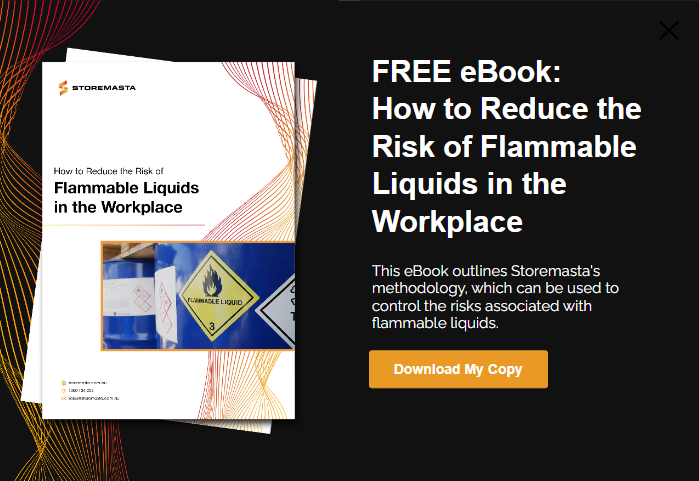If your business handles and dispenses Class 3 Dangerous Goods, your staff must be fully aware of all the hazards associated with the handling these volatile substances. The safety of your organisation lies in the hands of your workers — and if they’re not educated about the dangers associated with flammable liquids, they won’t have the knowledge to handle them in a safe and compliant way. This blog is dedicated to explaining the right way to handle Class 3 Flammable Liquids in the workplace, so you can reduce the risks to your people, property and the environment.
What Are The Hazards Associated With Flammable Liquids?
Flammable liquids are defined by their ability to emit enough flammable vapours to ignite at temperatures below 60 °C. In the presence of an ignition source, these vapours can quickly ignite and cause a fierce, fast burning fire that are generally very difficult to put out.

Flammable liquids can emit enough vapours at temperatures below 60 °C to ignite in the presence of an ignition source.
When working with Class 3 Dangerous Goods, it’s vital that all personnel who handle these substances are made aware of the risks. To stay safe and compliant, staff, supervisors and even contractors must all be educated in flammable liquids safety so they can maintain the correct handling and storage procedures.
Remember, due to the low flash point of flammable liquids, they can ignite at low temperatures — including room temperature. This means that your flammable chemicals pose a serious risk that must be controlled whenever staff are delivering, transferring, handling, dispensing and storing these flammable liquids.
Some hazards that flammable liquids present on the workplace include:
- Environmental damage from spills
- Asphyxiation from inhalation of flammable vapours
- Fires from the ignition of flammable vapours
- Violent chemical reactions from the mixing of incompatible chemicals
As the risks associated with flammable liquids are many and varied, it’s always a good idea to seek professional advice on how to minimise their impact upon your workplace.
We’ve collated some key best practices for the safe handling of flammable liquids. Read on to find out more about how you should handle these volatile substances.
How Should You Handle Large Packages Of Flammable Liquids?
With the increased use of flammable liquids in the last century, producers of flammable liquids now package their goods in much larger quantities. Some of the larger packages include 205 L drums and 1000 L intermediate bulk containers. If these containers are not handled with the correct equipment, there is the risk of bodily injury.
Intermediate bulk containers (IBC’s) must always be lifted in and out of chemical storage containers with a forklift. However, 205 L drums have a round shape and are therefore much harder to handle.
To safely handle round drums, you may need to consider forklift attachments. Also, keep in mind that when flammable liquids are decanted from larger 205 L drums, we highly recommend using drum handling equipment to reduce the risk of spills.
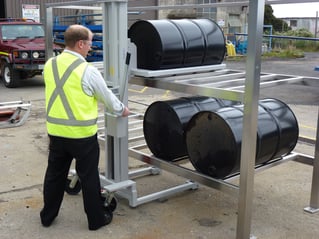 To reduce the risk of chemical spills, 205 L drums of flammable liquids should be decanted with the aid of drum handling equipment.
To reduce the risk of chemical spills, 205 L drums of flammable liquids should be decanted with the aid of drum handling equipment.
Where Should You Dispense Flammable Liquids?
When flammable liquids are used in the workplace, they may have to be dispensed from their original packaging before they can be used. However, during the dispensing process, the chemical will emit a large amount of flammable vapours.
As we’ve discussed earlier in this blog, these vapours have the potential to come into contact with ignition sources and cause severe fires. If large quantities of these vapours are inhaled by workers, they have the potential to cause asphyxiation and human harm. To control these risks, flammable liquids must be dispensed in well-ventilated areas.
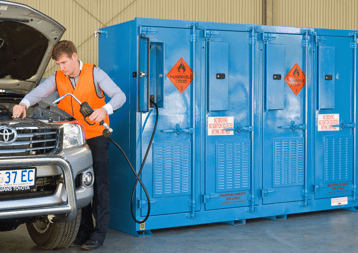 Due to hazardous vapours being emitted during the chemical dispensing process, you must only dispense flammable liquids in a well-ventilated work area.
Due to hazardous vapours being emitted during the chemical dispensing process, you must only dispense flammable liquids in a well-ventilated work area.
If your Class 3 Dangerous Goods can be dispensed in the outdoors, the air will naturally dilute the flammable vapours — and reduce the risk of asphyxiation. If dispensing must be conducted in an indoor environment, make sure that staff aren’t dispensing flammable liquids in enclosed areas such as in small compounds or rooms.
IMPORTANT: If flammable liquids are frequently dispensed indoors, it may be worth investing in a mechanical ventilation system that will safely remove all the flammable vapours.
Dangers Of Ignition Sources and Incompatible Chemicals
Another risk associated with dispensing flammable liquids is the potential for a chemical spill. When flammable vapours are released and spills occur, there is a risk that a fire or violent chemical reaction may occur if they may come into contact with ignition sources and other incompatible chemicals.
To avoid these risks, you should always ensure that flammable liquids are dispensed in an area that’s well away from ignition sources and incompatible chemicals. But how far is ‘well away’?
It’s recommended that Class 3 Flammable Liquids are dispensed in a work area that’s at least 3 metres away from all possible ignition sources, whether they’re mechanical, thermal or electrical. To avoid chemical reactions with incompatible substances, flammables must be dispensed at least 3 metres away from incompatible chemicals and 5 metres apart from chemicals that will react dangerously with them. Substances that will react dangerously with flammable liquids include Class 5.1 Oxidising Agents.
When Should PPE Be Used To Handle Flammable Liquids?
Personal protective equipment (PPE) is another control that can be used to reduce the risks associated with the handling and dispensing of flammable liquids.
While PPE can be effective, you should remember that it’s not a substitute for more effective controls, such as engineering and administrative controls. Some examples of PPE that can be used when handling flammable liquids include, respiratory equipment and gloves.
If the flammable liquids that are being dispensed give off high concentrations of flammable vapours that cannot be ventilated, respiratory equipment can be used to decrease the risk of asphyxiation and nausea.

To reduce the risks associated with handling and dispensing flammable liquids, PPE including respiratory equipment must be considered.
Do your Class 3 Flammable Liquids that you’re dispensing also have a corrosive sub-risk? You may implement the use of corrosive-resistant gloves when staff are dispensing flammable liquids as this will reduce the risk of burns.
IMPORTANT: Personal protective equipment should always be kept in a PPE cabinet that is easily accessible and situated close to your flammable storage cabinet.
Why Are Safety Data Sheets Important?
To ensure that all staff working with flammable liquids are aware of the specific hazards associated with their handling and storage, a copy of the Safety Data Sheet (SDS) for each flammable substance must be kept next to the area where the flammable liquids are stored.
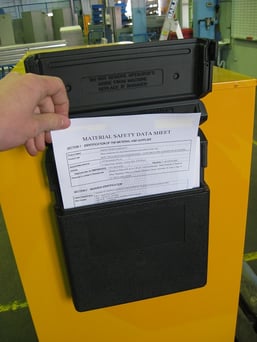 Keep your SDS for each flammable liquid chemical that you carry in a safe place that’s close to your flammable liquids stores.
Keep your SDS for each flammable liquid chemical that you carry in a safe place that’s close to your flammable liquids stores.
The SDS will outline the specific hazards of the chemical — such as reactivity, fire, health and environmental hazards associated with a particular flammable liquid. The document will also outline the basic storage and handling requirements for that particular type of chemical.
Before the dispensing of a Class 3 Flammable Liquid occurs, the SDS must be studied by staff so that they can make sure that the substance is being handled in the safest possible manner. To provide easy access to the SDS, these chemical documents must be kept in a durable document storage box which should be securely mounted on the flammable liquids storage cabinet.
By storing your SDS in a secure document storage box, you’re enabling all staff who handle these dangerous chemicals to have quick access to the SDS. Whether staff are handling, dispensing or storing the flammable liquids — or they’re facing an emergency situation — the SDS of your flammable chemicals is crucial to reducing chemical risk in the workplace.
How Can You Safely Store and Dispense Flammables?
When it comes to busy workplaces that carry flammable liquids, there are many innovations that can be utilised to increase safety and efficiency.
A flammable liquids dispensing station is specifically designed and constructed to store and dispense flammable liquids from a single module. It allows workplaces and remote work sites to store and dispense Class 3 chemicals in a faster, more streamlined manner while greatly reducing the risk of fire, explosion and human harm.
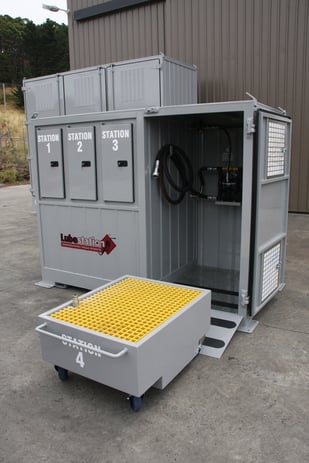 You can increase efficiency and reduce risk when handling flammable liquids through implementing innovative risk control measures such as a dispensing station.
You can increase efficiency and reduce risk when handling flammable liquids through implementing innovative risk control measures such as a dispensing station.
This unit benefits organisations who handle flammable liquids by minimising the risk of flammable liquids spills as well as the dispersion of hazardous flammable vapours.
IMPORTANT: Manufactured in full conformance to AS 1940:2017, the flammable liquids dispensing station is fitted with a spill containment sump, natural ventilation system, hose reels, dispensers and pumps.
How Are You Handling Your Class 3 Flammable Liquids?
As we've detailed in our blog, there are many hazards associated with the handling of flammable liquids. Any organisation that carries any type of Class 3 Dangerous Goods must ensure that they implement risk control measures to reduce the risk of asphyxiation, human harm, fire, explosion and environmental damage. If your business uses flammable liquids on a regular basis, it’s important that you store, handle and dispense these chemicals in a safe and compliant manner. This includes dispensing in well-ventilated areas, using drum handling equipment, consulting the safety data sheets, using PPE when necessary and investing in solutions such as flammable liquids dispensing stations.
Would you like to learn more about decreasing risk while increasing efficiencies in the storage and dispensing of flammable liquids? Our free guide, How To Reduce The Risk Of Flammable Liquids In The Workplace, details everything you need to know about identifying and controlling chemical risk. It will also introduce you to our 4-step methodology that can be easily applied to your own workplace. Click on the image below to get your free copy today.
Joining the team as a Dangerous Goods Storage Consultant, Melissa Hampton became Storemasta's Marketing Manager in late 2021. With extensive knowledge and experience in chemical compliance, Melissa is responsible for leading the Marketing team and helping shape their marketing strategy. In her spare time, you can find Melissa hiking, swimming and enjoying the great outdoors in beautiful north-west Tasmania.

